See how it works and what are the best email checkers with API capabilities.
Email validation is a process that checks if an email address is valid and deliverable. It confirms the email’s format, domain, and whether the mailbox exists, so you can be sure that all the great messages you sent are actually read.
Email validation helps you remove addresses that are:
- fake
- outdated
- have typos in them
- are spam traps
- are catch-all addresses
In short, validators help businesses keep a clean email list, reduce bounce rates and overall just a better return on investment from email as a channel. Even something as simple as a disposable email address can ruin your email campaign success.
What is an email validation API?
An API is a way for one computer program to ask another program to do something. For example, when you sign up on a website with your email, the site might use an API to ask an email validation service if your email is real and working.
Here’s a simplified breakdown of how email validation APIs work.
STEP 1: Validation request
An email marketing software (let’s call it Software A) needs to validate an email address. So, Software A sends an email validation request to the Email verification service’s API (Service B).
STEP 2: Email check
Service B’s API receives the email address, processes it, and verifies its validity. It checks parameters like domain existence, syntax errors, and more. This is when, e.g. the tool checks disposable email providers and removes these invalid addresses from your list.
STEP 3: Verification response
Once Service B has determined the validity of the email address, the API sends the validation results back to Software A.
STEP 4: Action or display
Depending on the validation response, Software A will flag invalid email addresses or add verified ones. It will show them on your API dashboard and you’ll know how many to remove from your email database. In the end, you’ll be left with a list of valid email addresses in your email program.
Why does email verification API matter?
Let’s stop for a moment and see how you may benefit from email verification API.
➡️ You save time as email validation API verifies instantly
Email validation happens right on the spot and gives businesses immediate feedback. As soon as someone enters their email address on your website, you’ll know if it’s valid or not.
➡️ You get genuine emails
There is no doubt that the collected email addresses are genuine. It reduces fake or incorrect data like invalid emails. Even one bad email can lower the deliverability of emails for your email marketing campaigns.
➡️ You experience fewer bounced emails
Sending communications to verified email addresses cuts down emails that don’t reach the intended inbox. Email service providers notice this and after the email verification process, your email marketing efforts are going to give better results.
➡️ You achieve better user engagement
Your messages connect with real people. It boosts engagement and response rates, as well as overall email marketing metrics. Once the email validation process is done, you’ll only communicate with real people, so your deliverability scores and quality scores will go up.
➡️ You avoid extra costs
Filtering out invalid email addresses avoids costs linked to sending messages to non-existent emails. For example, if someone adds fake emails to your capture form, every single email address means extra costs for your email marketing tool. The bigger your mailing lists, the higher your monthly bill.
➡️ You protect your business from fraud
Email verifier API is a security layer that wards off fraudulent sign-ups or submissions.
How should you choose an API validation tool?
It’s easy to get lost among so many tools and features available. Don’t worry, though. Here are a few tips on what to pay attention to before financially committing to an email validation service.
Consider the pricing and see if it fits within your budget
Price is one of the decisive factors here. Many businesses look for another solution if it is out of the budget. Go through the pricing pages, compare them with each other, and see what’s the best deal.
See if the service offers bulk email verification for large lists
If you have a big email list to check and want to catch all the duplicate emails or invalid domains, check on the bulk feature to remove bad email addresses in one go.
A good email checker API can scan lots of emails and notify you about disposable emails in the blink of an eye. It also spots invalid domains and may prompt visitors to resubmit with the suggested correction. All to make mail servers clean.
Remember, a verified email address is super important for maintaining a good relationship with mailbox providers, and risky emails mean trouble for email marketers.
💡 Verification API can remove spam traps – fewer emails go to free email providers that might block them. You get better overall email quality when using an email verification tool.
Do the research on the features
That’s a step that you cannot skip if you want to use the email validator to its fullest potential. Head to the website and go through the features.
Because if not, that would be a waste of money, right?
No matter how big your business is, here are some must-haves:
- typo check
- syntax check for your entire list of emails
- bulk email verification
- robust security
- high accuracy for every single email verification
- impeccable performance
- an API for email verification
Do you collect email addresses in your database? Do you use email marketing in your strategy? You can make the whole process faster! Let’s have a look at the list of the best email verifiers with API capabilities:
#1 Bouncer email verification API
It’s an email verification service for individuals and businesses of any size from any industry. Bouncer Email Verification API validates email addresses and checks delivery as you specify.
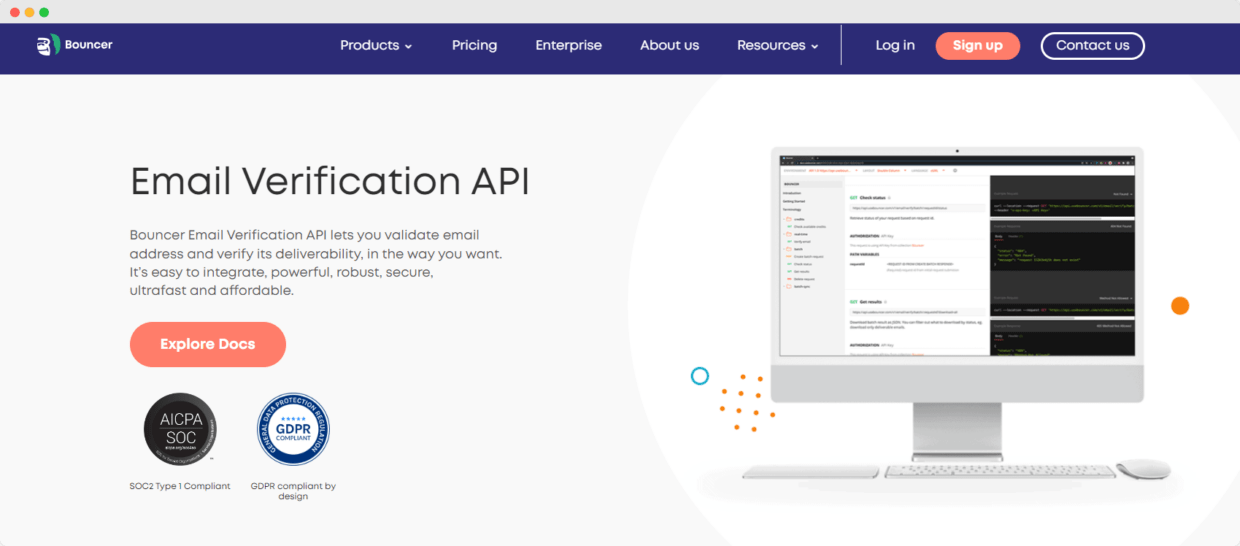
🟩 API features in Bouncer:
Real-time email verification– ultra-fast and designed for immediate email verification results.
Batch email verification – validate as many emails as you want in bulk.
Performance – can handle a batch size of up to 500,000 emails, but it’s recommended to process between 1,000 to 10,000 emails at a time. Bouncer can verify 100,000 emails per hour.
Rate limiting– for batch verification, it allows 200 requests per minute, and for real-time verification, it allows 1,000 requests per minute.
Security – GDPR compliant, anonymizes data in all parts of the system, allows removing all emails for good.
Data safety – all data is stored in AWS European Data Centers. Bouncer is GDPR and SOC2 Type 1 compliant.
API key– the API key can only be passed in the header, not the URL.
💡 Mind that putting the key in the URL is risky because places like website records, browser lists, or shared website links might show it. If someone sees this key, they might misuse it.
Support– they have a dedicated support team available via video call, chat, and email.
Documentation – Bouncer provides well-documented API with examples.
API is available in the as-you-go model. No matter the email you are about to check, you can always connect to Bouncer to verify your emails.
#2 ZeroBounce
This email validation system lets businesses connect with products and automatically checks their deliverability with API.
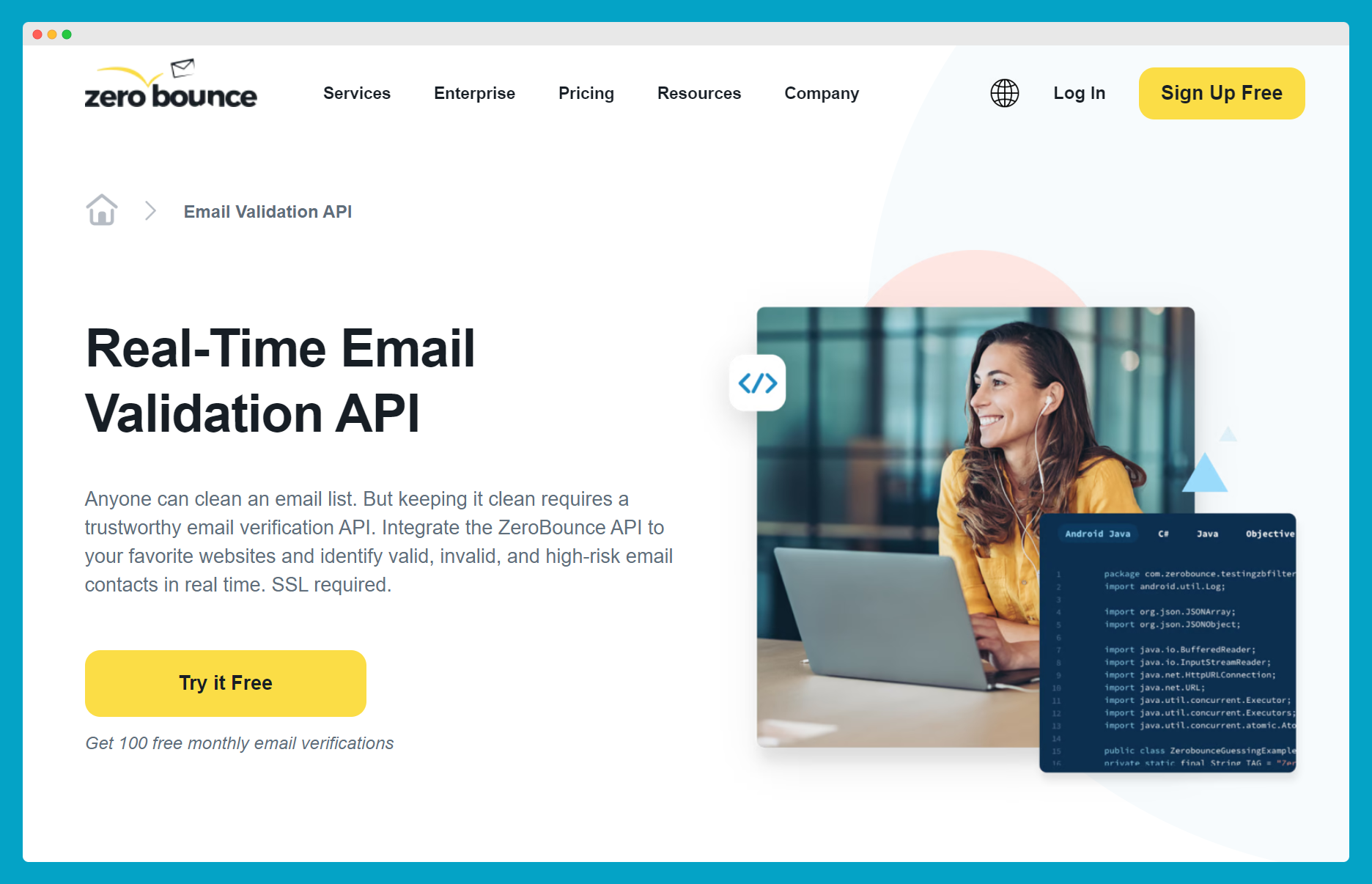
🟩 API features of ZeroBounce:
Real-time email validation– as users input their email addresses on registration forms, the system identifies the email type and acts as necessary.
Credit balance– you can see the remaining credits in your account, so you can track your API usage and plan ahead whether it’s time to buy more or not.
Files for bulk email validation transfer – it supports formats like CSV or TXT, and you can even specify details such as the column index for email addresses, first names, and more.
The status of the submitted file check –users know when the validation might be completed.
Retrieving your validation results – ZeroBounce API lets users fetch the validation results once your file has been processed. You can access and act upon the validated email data.
🟥 And some downsides:
Pricing – users have mentioned that ZeroBounce’s pricing is a bit high compared to other email verification and validation tools in the market.
Limited free trial– the free trial offered by ZeroBounce has certain restrictions on the number of email verifications or access to specific features.
Customer service issues – there are some complaints about customer service. Users state that they asked for a refund and were ignored.
💡 It’s always a good idea to thoroughly review the documentation and terms of service of any API or service. It will help you understand its specific limitations and capabilities.
ZeroBounce provides multiple API keys in all their pricing plans.
#3 AbstractAPI
AbstractAPI helps automate daily dev tasks. The tool is used to validate email addresses, geolocate IPs, calculate VAT, compress images, and more.
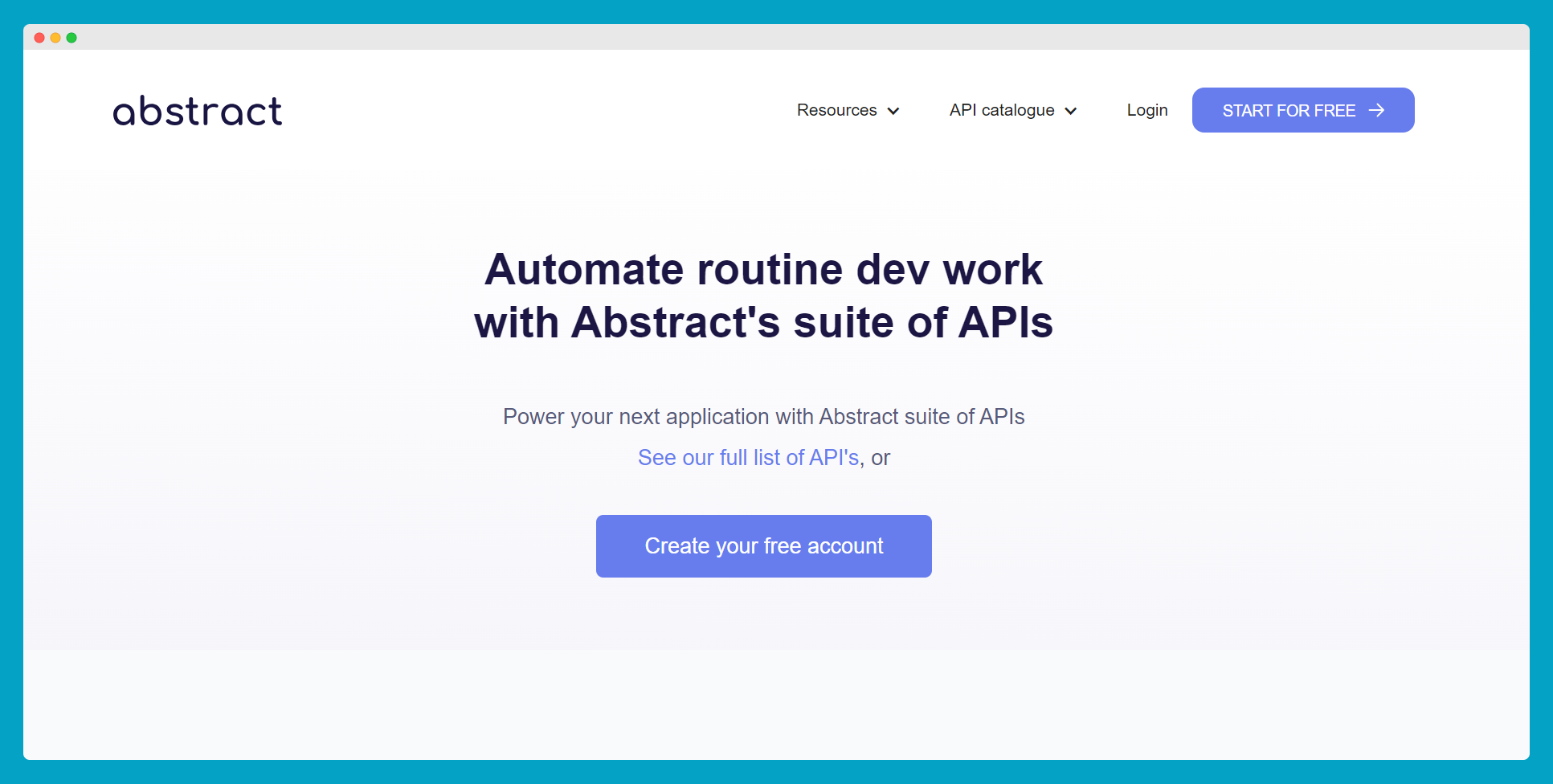
🟩 API features of AbstractAPI:
IP geolocation API – you can get geolocation data based on IP addresses.
Real-time verification – it verifies disposable emails, detects typos, and checks SMTP.
Simple integration with GET calls – AbstractAPI allows developers to access most APIs via GET requests.
🟥 And some downsides:
Complex integration for some – while Abstract API promotes easy integration, some developers might find the process challenging, especially if they’re unfamiliar with the specific API functionalities.
Data accuracy concerns –when dealing with vast datasets, there might be occasional inaccuracies in the data provided by the API.
Cost – depending on the volume and type of API calls, costs can accumulate, especially if you make frequent or large-scale requests.
Mixed reviews– many users don’t recommend this tool.
#4 CaptainVerify
If you want to validate email addresses using API, Captain Verify is a solid choice.
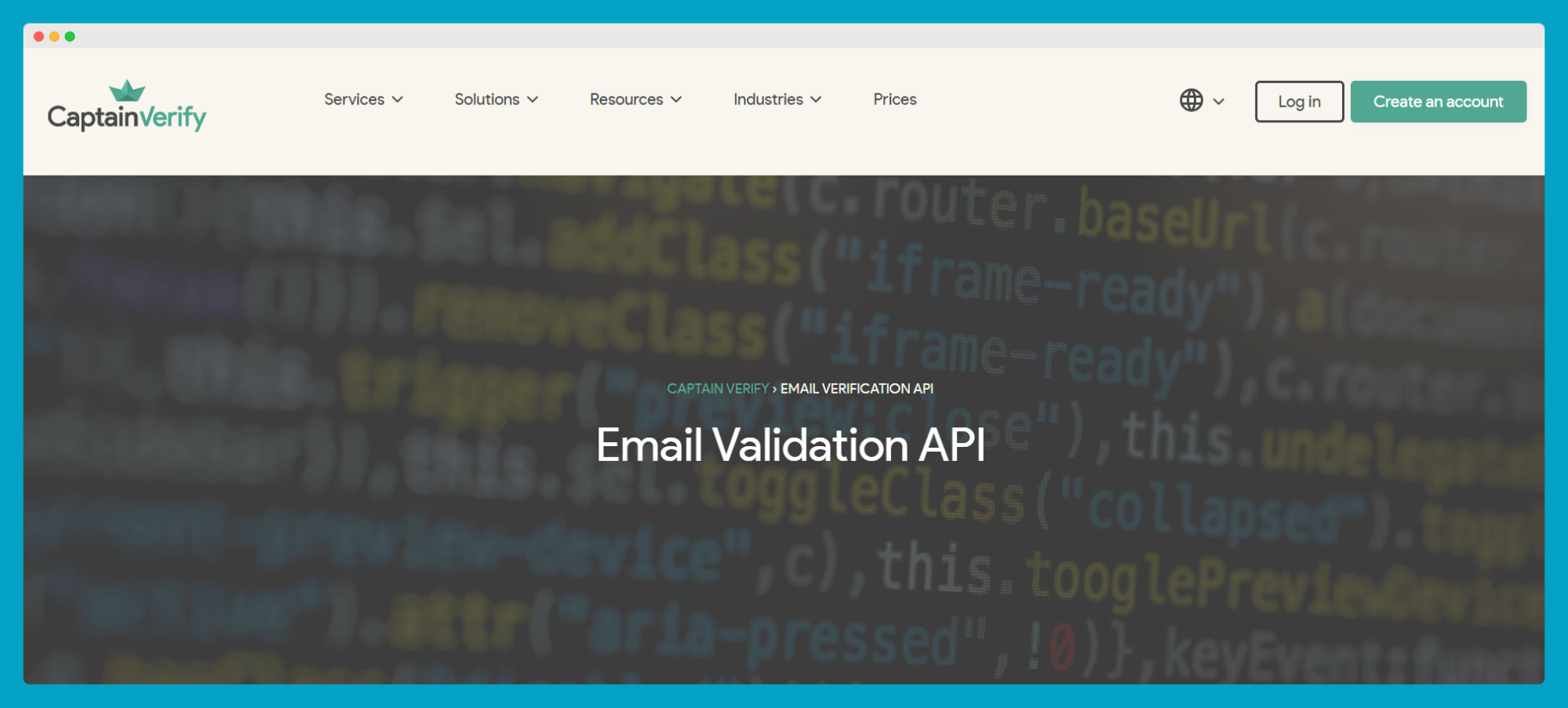
🟩 API features of CaptainVerify:
API V2 – CaptainVerify has introduced the second version of its API, which comes with new features tailored for email verification.
Email verification details – when an email is verified, the API returns a JSON table with various variables, including available credits, the email status (valid, invalid, risky, unknown), details about the audit result, and more.
🟥 And some downsides:
API limits – the API has a restriction of 2 simultaneous connections and allows up to 50 checks per minute.
Rate limits – there’s a cap of 50 checks per minute, which could be limiting for applications with high verification demands.
Dependency on credits – the API’s functionality is tied to the number of credits available in the user’s account. If all credits are exhausted, the API will always return an “unknown” status, potentially hindering the application’s operations.
You can use API in all the plans.
#5 Debounce
You can also integrate your product using Debounce API to catch the disposable email addresses. However, let’s go through its strong and weak suits first.
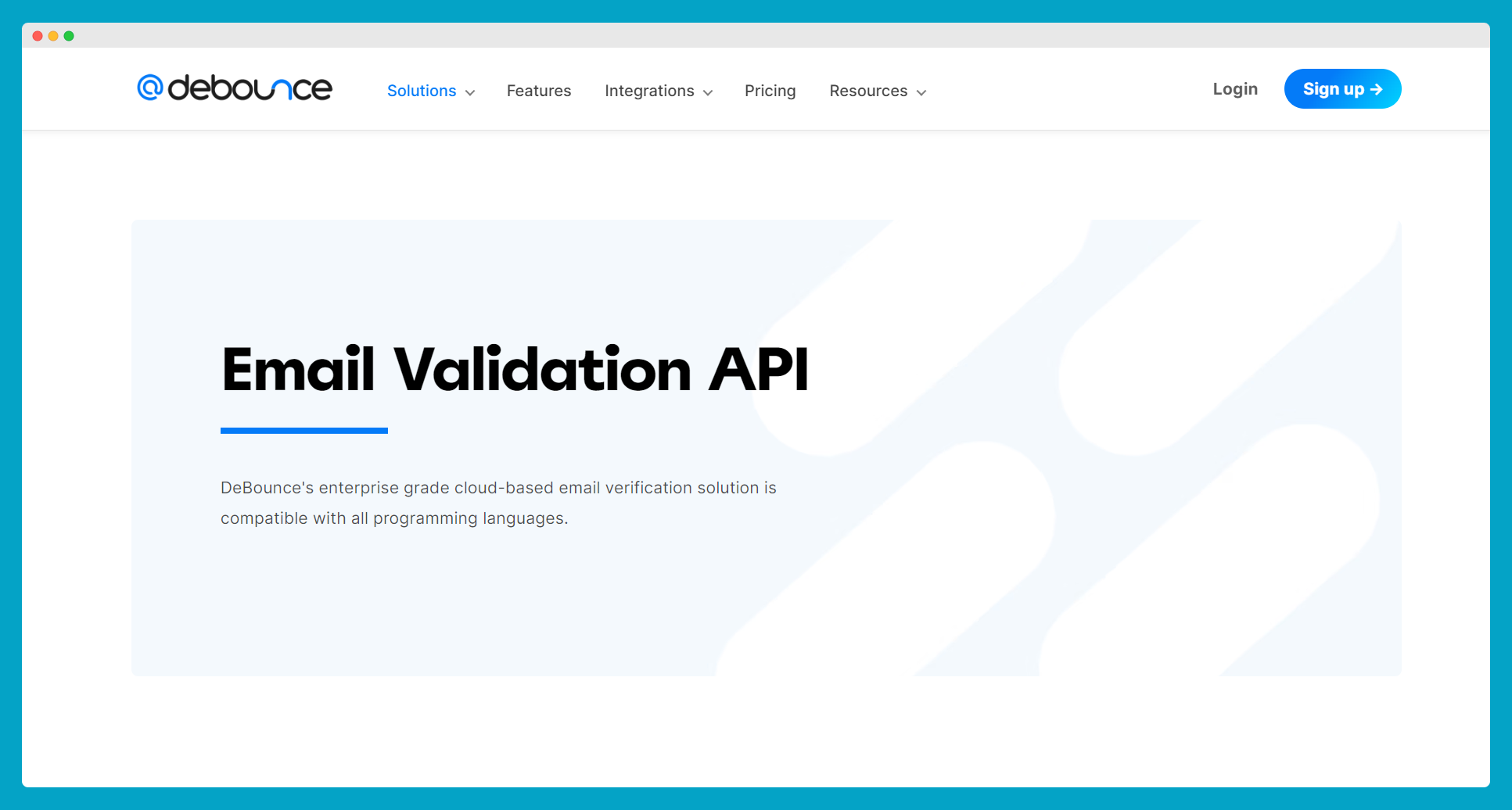
🟩 API features of Debounce:
Spam-trap indicators and SMTP checks – provide a clean email list, free of inactive or spammy addresses.
Email duplication prevention – catches and eliminates duplicate email addresses within a list.
MTA validation – verifies if the mail transfer agent (MTA) is available and capable of receiving emails.
DNS validation – confirms the existence of the domain name system (DNS).
🟥 And some downsides:
Users report result accuracy concerns – emails that DeBounce marked as invalid turned out to be valid when checked on another platform.
Limited analytics and logging – compared to some competitors, DeBounce offers fewer analytics options. Users may not get as much insight into their email verification processes.
API is included in all the plans available.
#6 Email Hippo
Email Hippo offers an email validation technology for improving email deliverability. You can use API as well.
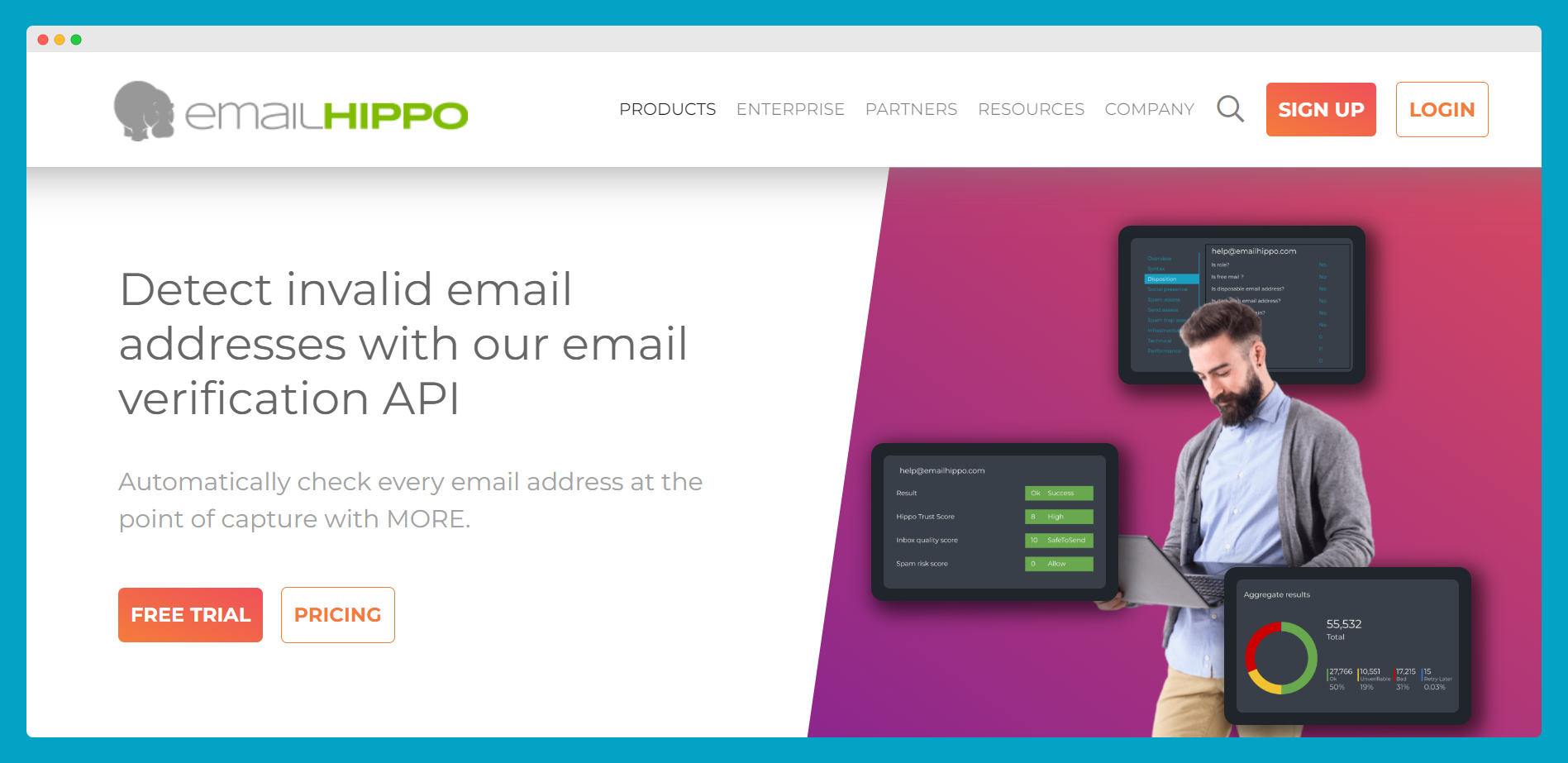
🟩 API features of Email Hippo:
Real-time API– beneficial for businesses or individuals that want to detect incorrect email addresses on the spot.
Syntax and format checks – the API checks for common syntax errors and verifies that the email format is correct.
Domain checks – Email Hippo determines if the domain exists and is set up to receive emails.
Disposable email detection– the service identifies and flags disposable email addresses, which are often used for one-time sign-ups that can harm your marketing campaigns, for example.
Free trial– Email Hippo offers 100 free email validations for new users.
🟥 And some downsides:
Pricing– it is very confusing, as the website doesn’t have a dedicated section with all the details explained about the plans.
Outdated UI –the interface could be more user-friendly. You might find it misleading, especially when looking for info in the documentation section about API.
Capabilities difference in plans – the plans contain different API features. The plan Edition 1 doesn’t provide MX record checking, blocklist, and anti-greylisting technology.
Email Hippo offers API in all the plans: Edition 1, Edition 2, and Enterprise.
#7 Sendgrid
SendGrid is a cloud-based email service that assists businesses with email delivery. It also provides API.
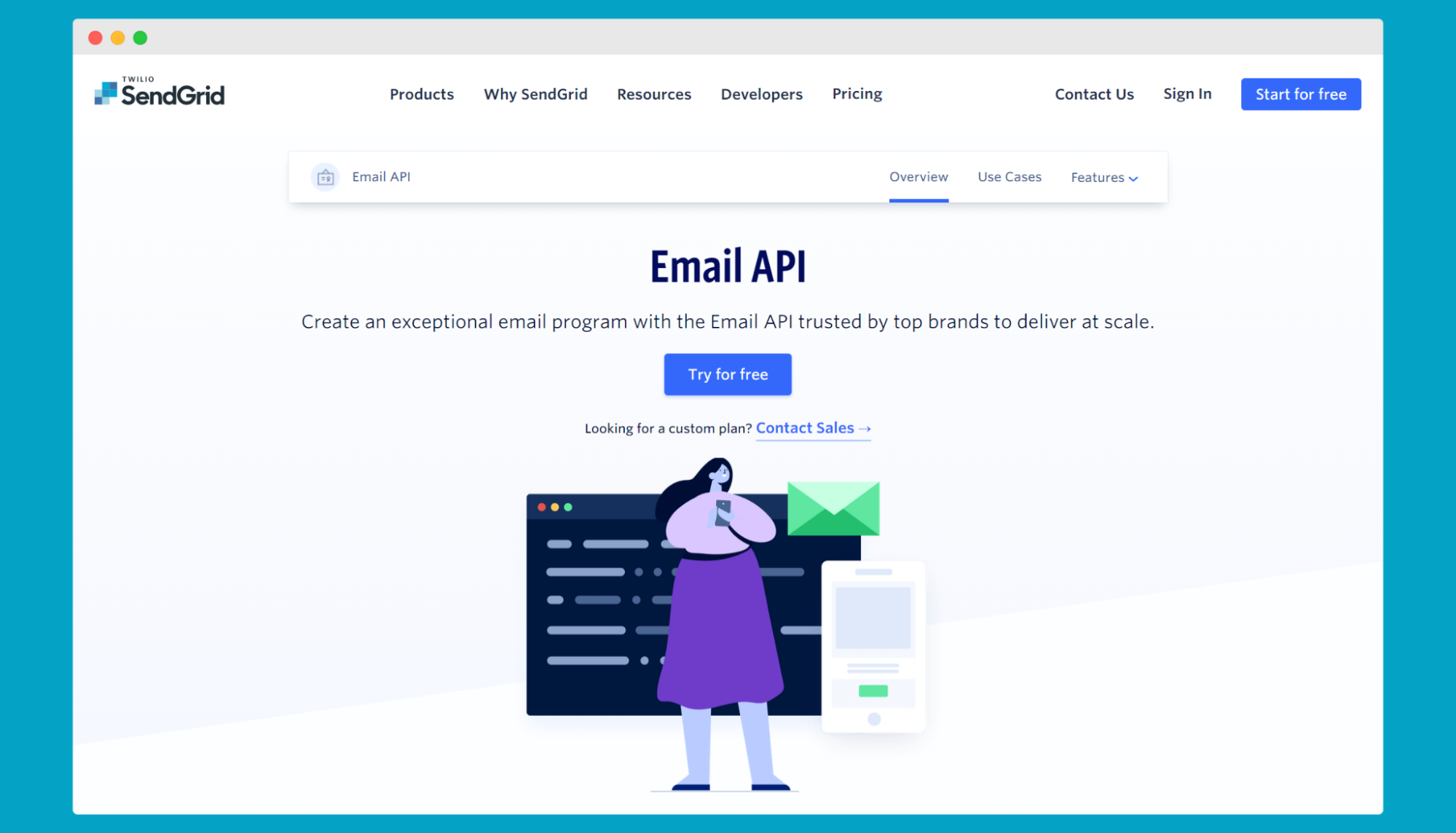
🟩 API features of Sendgrid:
Real-time email verification – Sendgrid validation API allows for real-time email verification, ensuring that email addresses are checked as soon as they’re entered.
Domain checks – the tool verifies if the domain exists and is set up to receive emails.
Spam trap detection – the service identifies and flags potential spam traps, which can harm your sender reputation.
Disposable email detection — Sendgrid’s API identifies and flags disposable email addresses.
Mailbox verification – It checks if the mailbox is active and can receive emails.
🟥 And some downsides:
Pricing – the pricing model might not be suitable for everyone, especially for businesses with high email validation needs.
Deliverability could be better – some users reported that their emails end up in the spam folder, even when using Sendgrid’s services.
Complex user interface– new users might find Sendgrid’s dashboard and settings a bit overwhelming.
API is included in all the plans, but the lowest package is very limited in terms of features.
#8 Emailable
Emailable API lets you connect to your website or the app to verify your emails. See its pros and cons.
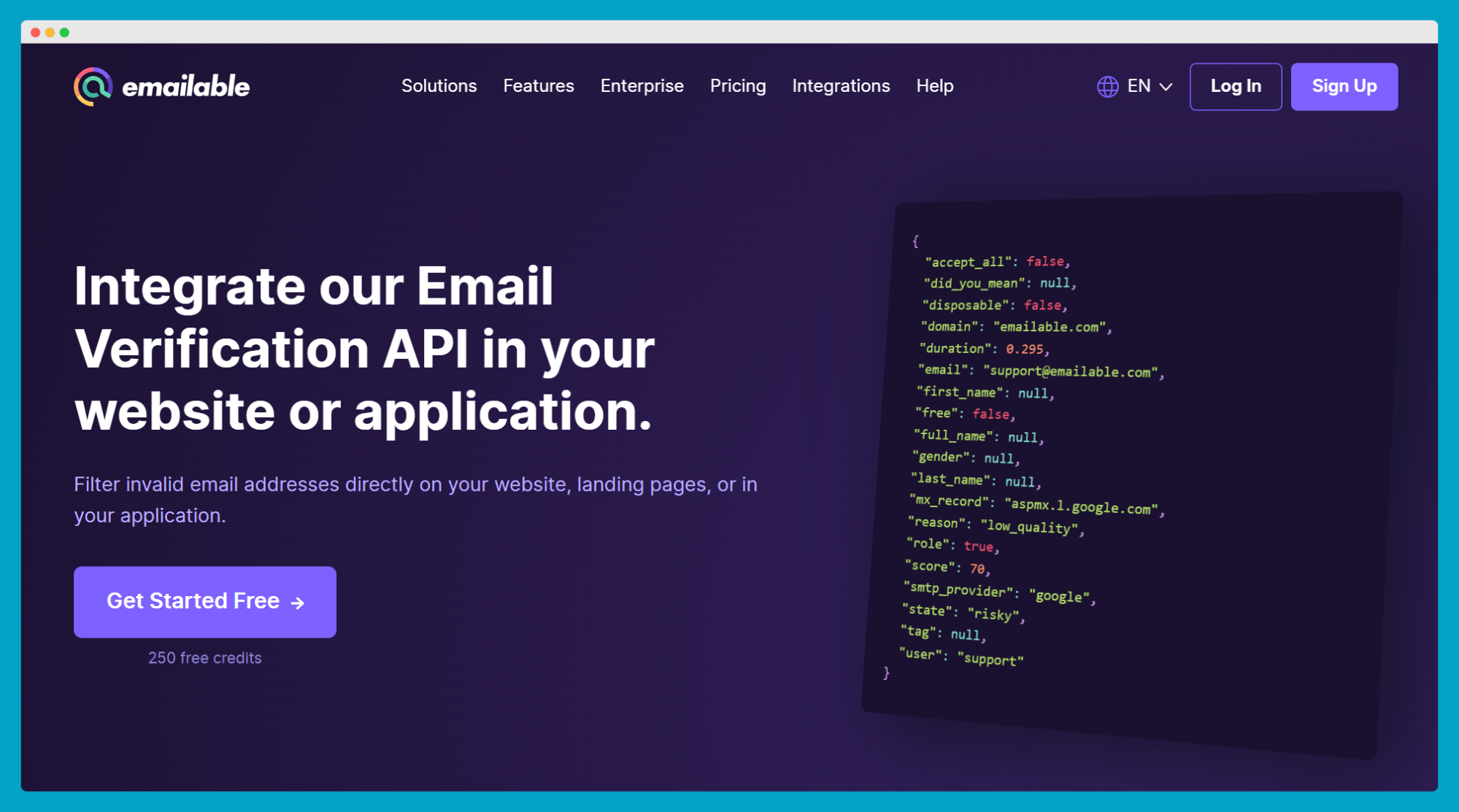
🟩 API features of Emailable:
Quick integration –modern tools and straightforward documentation make setup quick.
Batch operations support –Emailable’s API allows for processing multiple email addresses at once.
Client libraries –available in multiple languages for diverse development needs.
High emphasis on security– HTTPS, HSTS, and AES-256 encryption get data stored safely.
🟥 And some downsides:
Slow customer support– you can contact the support team via live chat, but users report they’re often offline.
API documentation– some users don’t find it detailed enough.
Email validation accuracy – a few users reported inaccuracies in email validation results (some deliverable emails flagged as undeliverable).

Which email verification API service will you choose?
Make validating email addresses a piece of cake. Integrate your product or website with API with the email checker, and be sure that your email list is crystal clear. But first, you need to pick the proper tool.
Not sure what’s the best option? Bouncer has a 99%+ accuracy rate and can validate 180,000 emails per client every hour. Also, it’s got fortress-like security. 💪🏻


